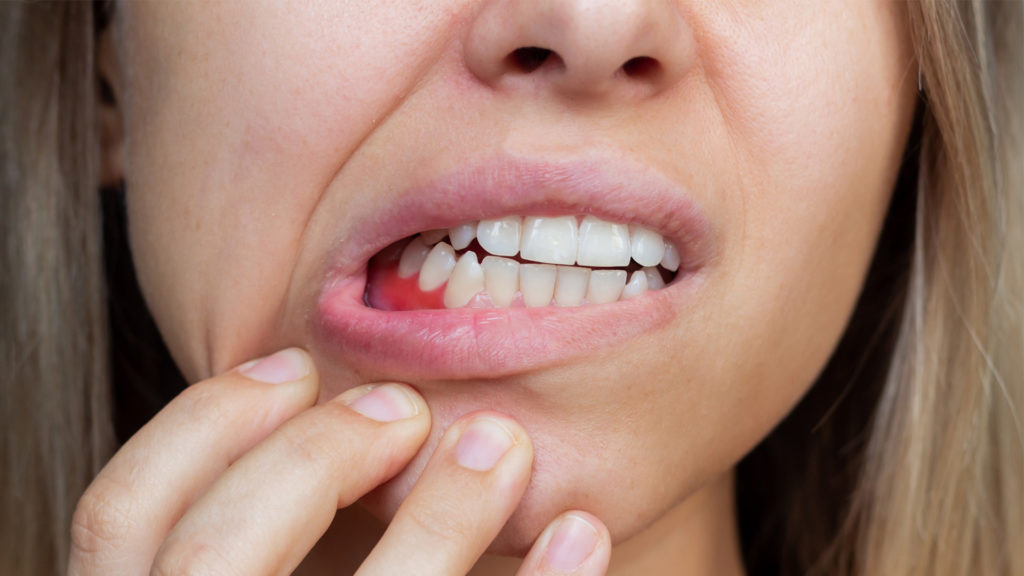What is Gum Disease?
Your gums may not be front-and-center when you smile, but they are the foundation for strong teeth and overall oral health. Gum diseases are bacterial infections that gradually erode the tissue of the gums, and they are the leading causes of tooth loss in adults. Protecting your gums with proper oral hygiene and regular checkups can improve your gum health, but if you suspect gum disease, it’s time to call a periodontist.
Signs of Gum Disease

Gum disease often develops silently. Many people don’t even realize they have a problem until it has already progressed. The best way to avoid gum disease is to have regular cleanings and checkups with a dentist skilled in recognizing the early signs. Keeping an eye out for the common symptoms can help you determine when it’s time to get help.
Gum disease can cause any of the following symptoms:
- Gum Swelling or Tenderness: noticeable or uncomfortable swelling in the gums; tenderness to the touch or while eating.
- Red or Inflamed Gums: gums that appear red, especially around the gumline, as well as painful inflammation. Remember: gums should be firm and pink.
- Bleeding when Brushing or Flossing: bleeding is a common sign of plaque and tartar buildup on the surface of the tooth, which causes the gumline to become sensitive and prone to bleeding.
- Receding Gums: Gumlines that are withdrawing can cause teeth to appear longer and be a result of plaque on the teeth – the gums begin receding to avoid irritation.
- Change in Bite: Gum disease can cause teeth to shift or become loose, which ultimately changes the familiar “bite” pattern.
- Loose Teeth: Again, your gums are the foundation your teeth are set into – when your gums are unhealthy, teeth can become loose, shift, and even fall out.
How Does Gum Disease Progress?
Gum disease is caused by poor oral hygiene. When plaque is left on the tooth for too long, the acids and bacteria in the plaque cause irritation in the gum tissue. This will inevitably lead to infection of the gum tissue, which progresses through two distinct phases: gingivitis and periodontitis.
Gingivitis
Gingivitis is the first stage of gum disease. Gum irritation has set in, and the gum responds by becoming red, swollen, and tender. Bleeding isn’t uncommon during brushing or flossing.
The best treatment is prevention – scheduling regular cleanings and checkups, maintaining good oral hygiene, and cutting down on acidic and sugary foods. If you already suspect gingivitis, it’s important to begin treatment right away. This can include professional cleaning, oral rinses, topical antiseptics and a reminder to keep up good oral hygiene practices.
Periodontitis
Untreated gingivitis will progress into periodontitis. While gingivitis is an uncomfortable and sometimes painful disease, development of periodontitis causes severe pain and damage. Even worse, periodontitis cannot be reversed – only slowed down.
Periodontitis occurs when the gum begins to pull away from the tooth in an attempt to escape the irritation caused by acids and bacteria in plaque. Receding gums create pockets between the gums and the teeth, which collect plaque and debris. It’s a vicious cycle – the gums recede further to avoid irritation, which causes, in turn, more irritation and more recession.
Over time, the bacteria and acid in plaque will destroy the gums and, eventually, the alveolar bone (which holds the tooth sockets) and jawbone. This will lead to infection, tooth loss, pain, and can even result in heart and lung diseases.
Treatment of Gum Disease
Gum disease treatment options range depending on the severity of the individual case.
All of these treatment options are available here at our office. We use state-of-the-art equipment, like the Prophy-Jet air polisher, to restore gums. It’s crucial to keep your gums healthy so you don’t end up needing emergency dentistry.

- Professional Dental Cleanings: Scheduling regular cleanings and checkups helps detect gum disease early, and reverse the effects of gingivitis.
- Scaling and Root Planing: This is a two-part deep cleaning process. Scaling is the process by which your dentist removes plaque and tartar trapped beneath the gumline. Root planing then smooths out the root of the tooth, encouraging the gums to reattach to the tooth.
- Laser Gum Therapy: Laser gum therapy works in conjunction with other treatment options. It removes enflamed gum tissue from around the root of your tooth, and then smoothes the tooth to prevent bacteria buildup.
- Pocket Reduction: Reducing and eliminating the places for bacteria to hide is an effective treatment method against gum disease.
At Dental Group of Beverly Hills, we’re committed to providing the best gum disease treatment and prevention services. Our team of experienced dentists in Beverly Hills is renowned for offering comprehensive dental services to keep your smile healthy and beautiful. Schedule an appointment today to experience our state-of-the-art treatments and personalized service from some of the top dentists in Beverly Hills.
Schedule Your Appointment Now:


